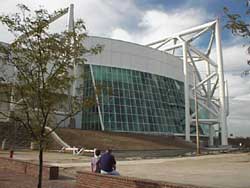|
Kansas City |

Kansas City
|
 Kansas City |
|
Kansas City Kansas City began as a trading post established by François Chouteau on the bluffs of the Missouri River in 1821. The post grew as overland trade and steamboat activity increased. During the great westward migration, the town, known then as Westport Landing, was an outfitting point for the Santa Fe and Oregon trails as well as for the California gold rush. In the 1850s growth was stopped by the bloody struggle between abolitionists and advocates of slavery for control of the territory of Kansas. In 1869 when the Hannibal and St. Joseph Railroad linked Kansas City with Chicago and other eastern markets its economic growth began again. In the 1880s the city became the nation's primary cattle trading center, and, soon after, a leading grain market. Modern Kansas City has nearly 200 of the nation's largest industrial firms, including auto assembly, steel and metal fabrication and food processing plants. Country Club Plaza, a tile-roofed, Moorish-style complex, was the first shopping center in the nation. Union Station, the country's second-largest train station, is now a shoo]ping center but during WWII half of all GIs sent to fight passed through Union Station. Crown Center, developed by Hallmark Cards Inc., includes a hotel as well as a shopping, dining and entertainment complex. The Harry S. Truman Sports Complex, with its twin stadiums for the Kansas City Royals baseball team and the Kansas City Chiefs football team is an important area attraction. Visitors can travel to Kansas city by car, train or plane. Kansas City, the largest city in the state of Missouri, has a population of 441,545. In 1900 the population was 163, 704. If early town leaders were able to see Kansas City today, they would be happy that their chosen name of Possum Trot did not stick. |
Links: |